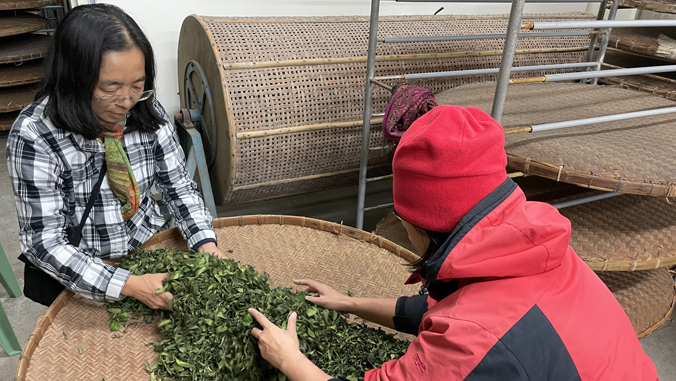
In February 2020, when University of Hawaiʻi at Mānoa Department of Geography and Environment Associate Professor Hong Jiang first learned she had won a Fulbright U.S. Scholars award for her academic research on tea cultures in Taiwan, she was thrilled. Little did Jiang know then that, due to COVID-19, she wouldn’t be able to start her Fulbright Taiwan program until September 2021.
It was worth the wait.

“There was a year-and-a-half delay for the trip due to the pandemic, and three weeks of quarantine once I arrived in Taiwan,” said Jiang. “But with the postponement, my time on the Fulbright program became even more precious, and I greatly appreciated the opportunity to research, teach and learn.”
The Fulbright Program offers international educational and cultural exchange for accomplished faculty to pursue important research and professional projects. In Jiang’s case, she sought to study the factors and processes for making oolong tea in Taiwan’s mountainous area—specifically the transformation from tea leaves to processed teas as a culture of taste.
“I visited the Alishan mountain range in central-southern Taiwan and interviewed tea farmers, tea processors and consumers,” said Jiang, who earned her BS and MS at Beijing Normal University, and her MA and PhD at Clark University in Worcester, Massachusetts. “I certainly enjoyed my time there and learned a lot.”
In fall 2022, she will impart some of that knowledge in Geography 432, Tea and Culture. In the meantime, she is seeking opportunities to publish her research with colleagues in Taiwan.
Related UH News stories:
- U.S. Sec. of State congratulates UH Mānoa as a top producer of Fulbright scholars, April 4, 2022
- UH Mānoa recognized as a top producer of Fulbright scholars, February 28, 2022
Excerpts from Jiang’s Fulbright online journal
“While I have studied tea and culture in China’s Tang through Ming dynasties, I came to Taiwan with no experience of tea making, and only rough ideas about Taiwan’s tea tree species, the variety of teas and the art of tea. Now having completed my program in Taiwan, I feel so enriched in my knowledge and experience of tea.
My trips to Alishan initiated my wandering in the land of tea, learning about and researching tea. My research focuses on factors affecting the process of Alishan high-mountain (gaoshan) tea-making—the transforming of the green tea leaves into a cultural taste, both literally and figuratively. Soon after my quarantine release in October 2021, I had the great fortune of meeting with Mr. Li Chan-Feng, an expert tea maker and teacher. He offered a surprise invite to come to the Alishan mountain to make oolong tea with him.
Oolong tea follows partial oxidation, a process that is very delicate. The withering process is particularly important and demanding, taking about 14-15 hours and keeping the tea-making team up through the night. Mr. Li was very particular about the oxidation process, making sure it is enough to allow the transformation of raw chemicals into a nice floral and fruity smell and taste. He lamented the reduced oxidation level in recent years that results in teas having a very grassy taste that some call “mountain taste,” irritating to the stomach. The withering process requires all senses to be intensely engaged: sight, hearing, touch, smell and taste—a complete lesson and experience in environmental phenomenology.
I made another longer visit to Alishan in early November toward the end of the winter tea-making season to interview tea makers about the taste of gaoshan tea. Everything worked out more amazingly than I had expected!
I stayed with a tea processing family at their B&B. My host there, Yun’an, really took care of me. I went with her everywhere as she picked tea and I interviewed tea processors. Surprisingly, when I had the wish to interview the village head in Taihe, the very first tea field that I walked to happened to belong to the village head! Going places with Yun’an also provided me opportunities to observe and understand different aspects of life in the tea-producing Alishan. As I learned about factors affecting the flavor of teas, I realized an important link I had not thought about before: wholesale buyers and retail customers of tea. This was when I learned that a wholesale buyer would also come to visit my host when some weekend travelers would also come to buy tea. I observed their interactions with Yun’an and learned much from them.
Of course, Alishan is so beautiful, and the mountains in front of the tea factory where I stayed were changing constantly with shifting clouds and lights, calling for tons of photos. The most striking was the rolling sea of clouds right on the front steps, and watching the whole sky, including tea leaves, turning rosy red at sunset—a magical moment after stepping out of the home of an expert tea maker.”

